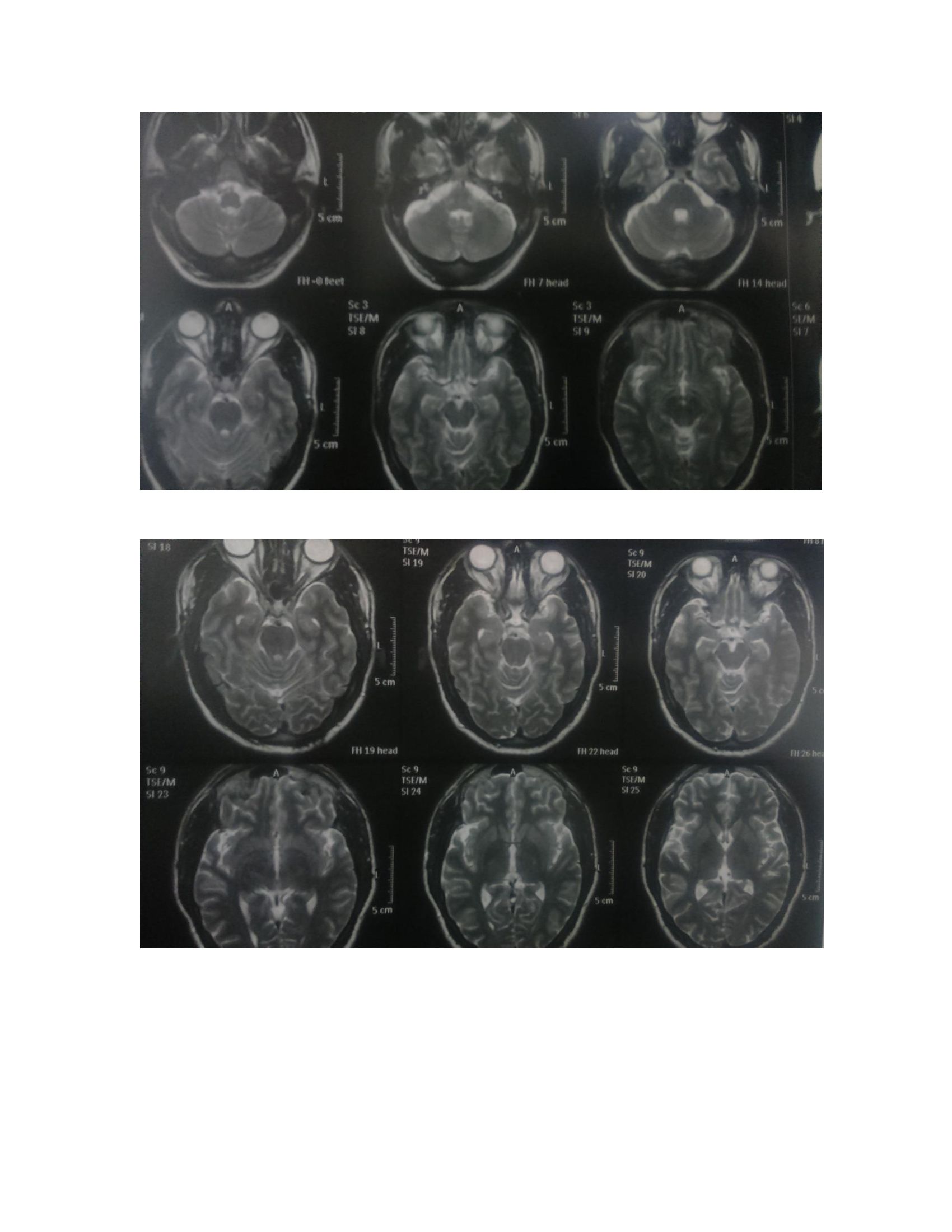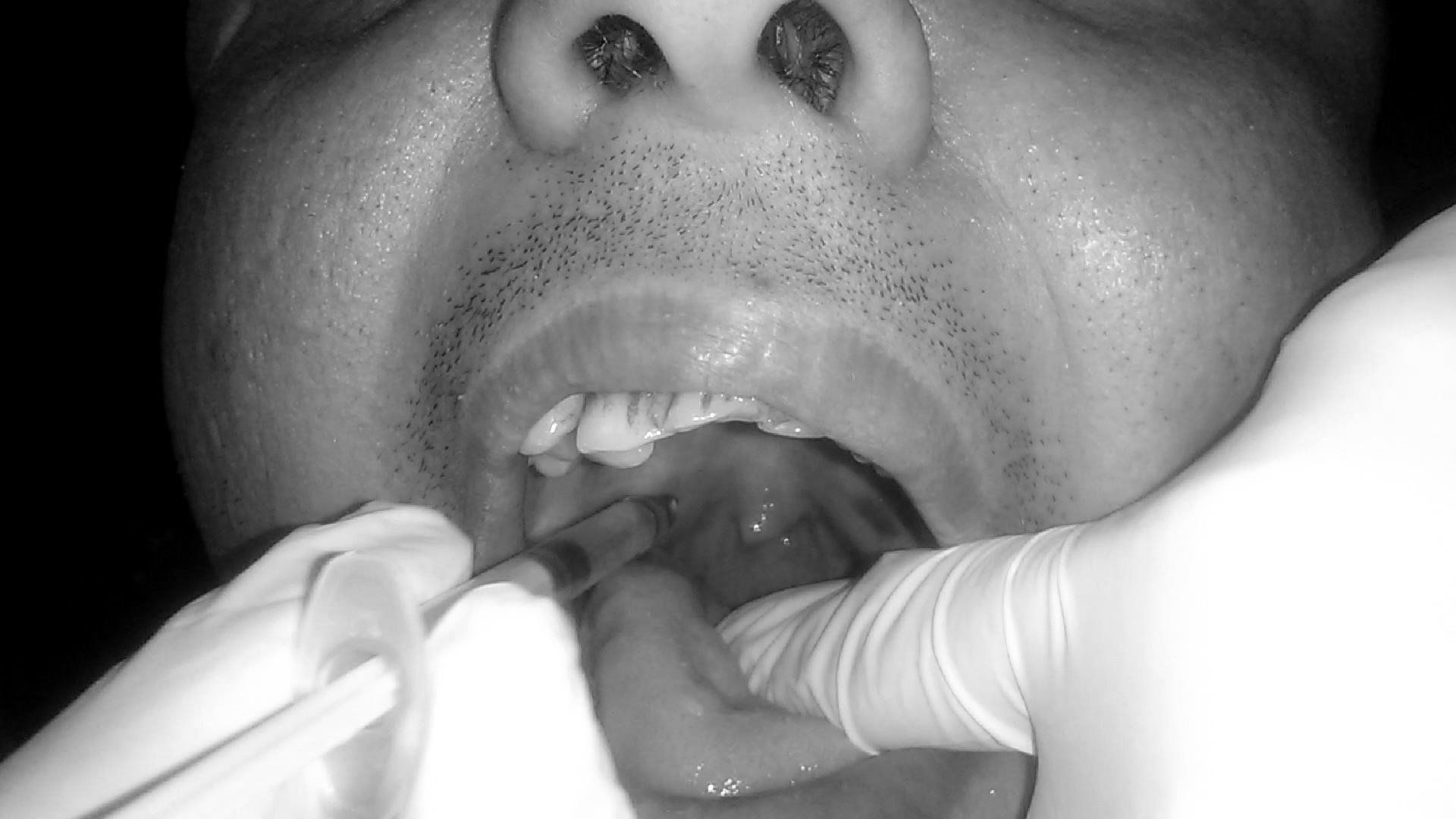Blog
Article
Effective Treatment of Essential Palatal Tremor and Coexistent Bipolar Disorder: A Case Report
Author(s):
Clicking sounds in the patient’s ears were initially thought to be auditory hallucinations, but a thorough neurological examination revealed the true cause.
Figure 1. Magnetic resonance brain axial T2 cuts supratentorial and infratentorial show normal brain parenchyma.

Figure 2. Botulinum toxin injection technique is demonstrated in the patient in this case.

CHALLENGING CASES
Palatal tremor is an uncommon type of movement disorder characterized by a clicking sound in the ear. Previously known as palatal myoclonus, it has recently been renamed as essential palatal tremor (EPT).1 Palatal tremor is classified into two subtypes: (1) symptomatic type secondary to lesions in the triangle of Guillain and Mollaret and (2) essential type that has no known intracranial pathology associated with it.2 Essential type usually affects children, whereas symptomatic type is commonly observed in men.1
Despite treatment with anticonvulsants and anxiolytics, the therapeutic response remains unsatisfactory. There is no specific treatment currently, although successful trials of botulinum toxin injection have been reported.3
Patients with neurological disorders frequently have mood disorders. Major depression and dysthymia are the most common; less commonly, bipolar disorders can also occur as a consequence of a neurological disorder. In addition to the disorders themselves, manic symptoms can occur secondary to neurological medications.4
Growing evidence suggests that botulinumtoxin has antidepressant effects, with a response rate of 50% to 60% in treatment of major depression in patients with primary neurological disorders such as movement disorders in the head and neck-hemifacial spasm or benign essential blepharospasm.5,6 The following case is of a patient with EPT and comorbid bipolar disorder who was successfully treated with botulinum toxin injection.
Case presentation
A 30-year-old unemployed man with no past medical history presented to the Kasralainy Hospital Movement Disorders Clinic in Cairo, Egypt. He had a 5-year history of click sounds in both ears, associated with intermittent and rhythmic movements in the throat; the clicking sound disappears during sleep.
Two years after the onset of symptoms, the patient sought medical advice at a psychiatric clinic. He complained of depressive symptoms with episodes of irritability and anxiety. In addition, he experienced a clicking sound in the ear that was thought to be auditory hallucinations. He received a diagnosis of bipolar disorder with manic episodes.
He was started on 1500-mg sodium valproate, 10-mg escitalopram, 100-mg sulpiride, and 200-mg quetiapine daily. The patient experienced improvement in psychiatric symptoms; however, there was almost no improvement in the clicking sound.
During his first visit to our clinic, we performed a full general and neurological examination, including oral examination that revealed rhythmical contractions of the soft palate bilaterally. A magnetic resonance imaging (MRI) scan of the brain showed no abnormality (Figure 1). Accordingly, the patient received a diagnosis of EPT.
The patient was prescribed clonazepam but refused to take more medications and asked for other treatment options. We offered a trial of botulinum toxin type A injection and explained to the patient the possible complications identified in the literature.
A total of 11 U of botulinum toxin type A was injected (on each side) in the tensor veli palatini muscle without local anesthetic (Figure 2). Specifically, 8 U was injected into the lateral soft palate just medial to the pterygoid hamulus and 3 U into the medial soft palate lateral to musculus uvulae.
At 1 week during follow-up, the patient had a marked decrease in severity and frequency of palatal tremor, and decreased intensity of clicking sound in the ear; however, he experienced adverse effects associated with bulbar symptoms including hypernasal speech and nasal regurgitation of fluids. Fortunately, the patient was able to tolerate the symptoms, and they resolved within one week. His psychiatric symptoms also improved; thus, the psychiatrist decreased the medication dosages during his follow-up visits to the psychiatry clinic.
The patient was satisfied with the treatment and overall response and was instructed about regular follow-up. He achieved relief of symptoms for about 4 to 5 months, and another injection was scheduled.
Discussion
Symptomatic palatal tremor is secondary to a lesion in the brain such as vascular infarcts and pathologies in the dentate-rubro-olivary pathway. EPT is usually associated with objective tinnitus that disappears during sleep. It has been hypothesized that the click sound is created by sudden opening of the eustachian tube and subsequent rapid breakdown of surface tension within the tube.7
Bipolar disorder is a clinical diagnosis and must be differentiated from secondary causes with similar clinical presentations such as vitamin deficiencies, drug adverse effects, and heavy metal toxicity.8 Therefore, a detailed neurological and psychiatric examination with appropriate investigations with (but not limited to) an MRI brain scan is mandatory. In our case, a diagnosis of bipolar I disorder was made based on DSM-5 criteria.
The interpretation of the click sound that the patient experienced as auditory hallucinations was due to the rarity of EPT and its coexistence with bipolar mood disorder, which was similar to the case report described by Norouzian and Mir-Sepasi.9
Depressive symptoms can be attributed to either secondary to the neurological condition-EPT in our case-or due to the fact that most patients with manic episodes that meet DSM-5 criteria for bipolar disorder also experience major depressive episodes during the course of their illness.8
The effect of botulinum toxin injection in improving depression in our patient may be explained by the proposed hypothesis of facial feedback, which postulates that depression and low mood are associated with abnormal facial expression. Therefore, improving facial expression as a result of botulinum toxin injection will lead to resolution of depressive symptoms.10
Conclusion
EPT is rare, and there are nearly no reports in the literature of its coexistence with bipolar disorders. This case report confirms the importance of a meticulous neurological examination in all patients, including those with psychiatric disorders. Attributing unusual complaints of psychiatric patients only to their psychiatric disease is baseless-even rare, and uncommon signs and symptoms need further investigations.
Large-scale studies are needed to determine the efficacy and safety of botulinum toxin injection in the treatment of mood disorders.
Dr Ibrahim is Lecturer, Department of Neurology, Kasralainy Hospital, Faculty of Medicine, Cairo University, Egypt. He reports no conflicts of interest concerning the subject matter of this article.
References:
1. Margari F, Giannella G, Lecce PA, et al. A childhood case of symptomatic essential and psychogenic palatal tremor. Neuropsychiatr Dis Treat. 2011;7:223-227.
2. Kitamura T, Sato T, Hayashi N, et al. Essential palatal tremor managed by cognitive behavioral therapy. Case Rep Dent. 2015;2015:2-4.
3. Campistol-Plana J, Majumdar A, Fernandez-Alvarez E. Palatal tremor in childhood: clinical and therapeutic considerations. Dev Med Child Neurol. 2006;48:982-984.
4. Schneck CD. Bipolar disorder in neurologic illness. Curr Treat Options Neurol. 2002;4:477-486.
5. Finzi E, Rosenthal NE. Emotional proprioception: treatment of depression with afferent facial feedback. J Psychiatr Res. 2016;80:93-96.
6. Fan S, Peng G. Botulinum toxin relieves anxiety and depression in patients with hemifacial spasm and blepharospasm. Neuropsychiatr Dis Treat. 2019;15:33-36.
7. Slengerik-Hansen J, Ovesen T. Botulinum toxin treatment of objective tinnitus because of essential palatal tremor: a systematic review. Otol Neurotol. 2016;37:820-828.
8. Ayano G. Bipolar disorder: a concise overview of etiology, epidemiology diagnosis and management: review of literature. Symbiosis Open Access J Psychol. 2016;3:1-8.
9. Norouzian M, Mir-Sepasi GR. Essential palatal myoclonus accompanied with psychiatric symptoms. Arch Iran Med. 2000. http://www.ams.ac.ir/AIM/0034/norouzian0034.html. Accessed May 1, 2019.
10. Greden JF, Genero N, Price HL. Agitation-increased electromyogram activity in the corrugator muscle region: a possible explanation of the “Omega Sign”?Am J Psychiatry. 1985;142:348-351.
Newsletter
Keep your finger on the pulse of neurology—subscribe to NeurologyLive for expert interviews, new data, and breakthrough treatment updates.





